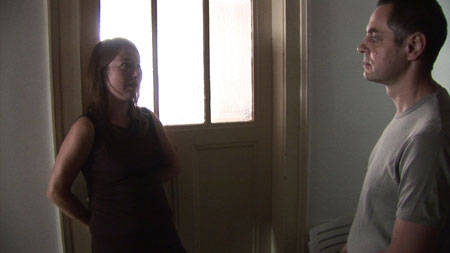Jan Mancuska
19 Jan - 24 Feb 2007
JAN MANCUSKA
"A Gap"
Four simultaneous video projections with soundtracks, installation
An explanation:
The film installation A Gap... created specially for the Meyer Riegger gallery space. The screenplay, characters and, to a certain extent, the film’s story are largely derived from the gallery’s layout or ground plan. Four video projections are positioned independently of each other in the gallery's various rooms. Each projection represents one character. All the videos play simultaneously. The film’s story is gradually presented by the four characters, who, however, appear in different rooms in the gallery and cannot be seen at the same time. Time gaps initially separate the story’s individual scenes and so the viewer can move from one room to the next and follow in sequence the film’s story told by various characters. But then the tempo gradually speeds up and the sequences of the different characters begin to overlap until it reaches the point when all the videos are playing at once. The way in which the film is viewed is then up to the viewer and depends partly on chance. Yet to understand the story, all the dramatic links of the characters must be viewed. Thus the viewer is forced to return to the characters and to use his memory to reconstruct the film's story.
The disposition of the gallery’s space influenced the characters’ identity. While the front part consists of mutually connected rooms, the back show-room is separated from the rest of the exhibition space by the office. So the character presented in the show-room is condemned to solitude and is aside of the film's story line. This character's link to the other characters only occurs indirectly at the end of the film.
The story of three people, linked and meeting in relationships on varying emotional levels, is played out in the gallery’s main rooms. An injury to the main character has him forgetting the previous events: it’s up to the others whether to reveal the actual state of things to him.
The A Gap project shows film as its own theme. It critically works with the method of constructing a story and the possibilities of transforming a space using dramatic structures. In the gallery, the viewer is exposed to the need to return to the different characters and to use his memory to compose the film’s action. All of this is played out in the film’s gaps, just like the gap is the theme of the film itself. The gallery's space is also a gap that becomes a passageway between the video projections, thereby materialising in its void.
© Jan Mancuska
A Gap, 2007,
film installation with four simultaneous video projections, sound
"A Gap"
Four simultaneous video projections with soundtracks, installation
An explanation:
The film installation A Gap... created specially for the Meyer Riegger gallery space. The screenplay, characters and, to a certain extent, the film’s story are largely derived from the gallery’s layout or ground plan. Four video projections are positioned independently of each other in the gallery's various rooms. Each projection represents one character. All the videos play simultaneously. The film’s story is gradually presented by the four characters, who, however, appear in different rooms in the gallery and cannot be seen at the same time. Time gaps initially separate the story’s individual scenes and so the viewer can move from one room to the next and follow in sequence the film’s story told by various characters. But then the tempo gradually speeds up and the sequences of the different characters begin to overlap until it reaches the point when all the videos are playing at once. The way in which the film is viewed is then up to the viewer and depends partly on chance. Yet to understand the story, all the dramatic links of the characters must be viewed. Thus the viewer is forced to return to the characters and to use his memory to reconstruct the film's story.
The disposition of the gallery’s space influenced the characters’ identity. While the front part consists of mutually connected rooms, the back show-room is separated from the rest of the exhibition space by the office. So the character presented in the show-room is condemned to solitude and is aside of the film's story line. This character's link to the other characters only occurs indirectly at the end of the film.
The story of three people, linked and meeting in relationships on varying emotional levels, is played out in the gallery’s main rooms. An injury to the main character has him forgetting the previous events: it’s up to the others whether to reveal the actual state of things to him.
The A Gap project shows film as its own theme. It critically works with the method of constructing a story and the possibilities of transforming a space using dramatic structures. In the gallery, the viewer is exposed to the need to return to the different characters and to use his memory to compose the film’s action. All of this is played out in the film’s gaps, just like the gap is the theme of the film itself. The gallery's space is also a gap that becomes a passageway between the video projections, thereby materialising in its void.
© Jan Mancuska
A Gap, 2007,
film installation with four simultaneous video projections, sound

